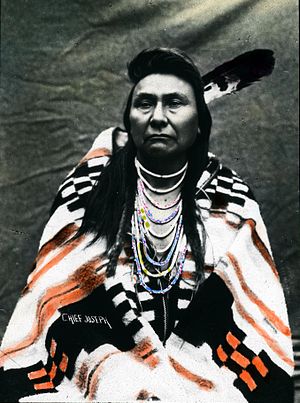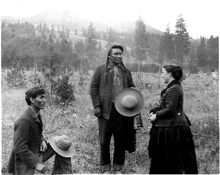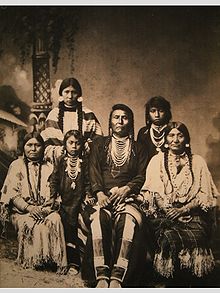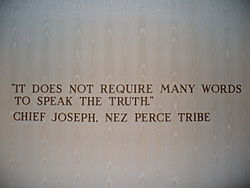- Chief Joseph
-
Joseph the Younger 
Tribe Nez Perce
1871–1904Born March 3, 1840
Wallowa ValleyDied September 21, 1904 (aged 64)
Colville Indian ReservationPredecessor Joseph the Elder Native name Hinmatóowyalahtq’it (Aoki 1994:155) Nickname(s) Chief Joseph Cause of death Natural causes Resting place Nespelem, Washington Spouse(s) Heyoon Yoyikt
SpringtimeChildren Jean-Louise, daughter Parents Tuekakas (father)
Khapkhaponimi (mother)Relatives Sousouquee (elder brother)
Ollokut (younger brother)
four sistersHin-mah-too-yah-lat-kekt, popularly known as Chief Joseph, or Young Joseph (March 3, 1840 – September 21, 1904) was the leader of the Wal-lam-wat-kain (Wallowa) band of Nez Perce during General Oliver O. Howard's attempt to forcibly remove his band and the other "non-treaty" Nez Perce to a reservation in Idaho. For his principled resistance to the removal, he became renowned as a humanitarian and peacemaker.
Contents
Background
Joseph was born Hinmuuttu-yalatlat (alternatively Hinmaton-Yalaktit or Hin-mah-too-yah-lat-kekt, Nez Perce: "Thunder Rolling Down the Mountain") in the Wallowa Valley of northeastern Oregon. He was known as Young Joseph during his youth because his father, Tuekakas,[1] was baptized with the same Christian name, later becoming known as "Old Joseph" or "Joseph the Elder."[2]
While initially hospitable to the region's newcomers, Joseph the Elder grew wary when settlers wanted more Indian lands. Tensions grew as the settlers appropriated traditional Indian lands for farming and grazing livestock.
Isaac Stevens, governor of the Washington Territory, organized a council to designate separate areas for natives and settlers in 1855. Joseph the Elder and the other Nez Perce chiefs signed a treaty with the United States establishing a Nez Perce reservation encompassing 7.7 million acres (31,000 km²) in present-day Idaho, Washington, and Oregon. The 1855 reservation maintained much of the traditional Nez Perce lands, including Joseph's Wallowa Valley.[3]
An influx of new settlers caused by a gold rush led the government to call a second council in 1863. Government commissioners asked the Nez Perce to accept a new, much smaller reservation of 780,000 acres (3,200 km2) centered around the village of Lapwai in Idaho, and excluding the Wallowa Valley. In exchange, they were promised financial rewards and schools and a hospital for the reservation. Lawyer and one of his allied chiefs signed the treaty on behalf of the Nez Perce Nation, but Joseph the Elder and several other chiefs were opposed to selling their lands, and did not sign.[4][5][6]
Their refusal to sign caused a rift between the "non-treaty" and "treaty" bands of Nez Perce. The "treaty" Nez Perce moved within the new Idaho reservation's boundaries, while the "non-treaty" Nez Perce remained on their lands. Joseph the Elder demarcated Wallowa land with a series of poles, proclaiming, "Inside this boundary all our people were born. It circles the graves of our fathers, and we will never give up these graves to any man."
As chief
 An 1889 photograph of Joseph speaking to ethnologist Alice Cunningham Fletcher and her interpreter James Stuart.
An 1889 photograph of Joseph speaking to ethnologist Alice Cunningham Fletcher and her interpreter James Stuart.
Joseph the Younger succeeded his father as leader of the Wallowa band in 1871. Before his death, the latter counseled his son:
My son, my body is returning to my mother earth, and my spirit is going very soon to see the Great Spirit Chief. When I am gone, think of your country. You are the chief of these people. They look to you to guide them. Always remember that your father never sold his country. You must stop your ears whenever you are asked to sign a treaty selling your home. A few years more and white men will be all around you. They have their eyes on this land. My son, never forget my dying words. This country holds your father's body. Never sell the bones of your father and your mother.[7]Joseph commented "I clasped my father's hand and promised to do as he asked. A man who would not defend his father's grave is worse than a wild beast."
The non-treaty Nez Perce suffered many injustices at the hands of settlers and prospectors, but out of fear of reprisal from the militarily superior Americans, Joseph never allowed any violence against them, instead making many concessions to them in hopes of securing peace.
In 1873, Joseph negotiated with the federal government to ensure his people could stay on their land in the Wallowa Valley. But in 1877, the government reversed its policy, and Army General Oliver Howard threatened to attack if the Wallowa band did not relocate to the Idaho Reservation with the other Nez Perce. Joseph reluctantly agreed. Before the outbreak of hostilities, General Howard held a council to try to convince Joseph and his people to relocate. Joseph finished his address to the General, which focused on human equality, by expressing his "[disbelief that] the Great Spirit Chief gave one kind of men the right to tell another kind of men what they must do." Howard reacted angrily, interpreting the statement as a challenge to his authority. When Toohoolhoolzote protested, he was jailed for five days.
The day following the council, Joseph, White Bird, and Looking Glass all accompanied General Howard to look at different areas. Howard offered them a plot of land that was inhabited by Whites and Native Americans, promising to clear them out. Joseph and his chieftains refused, adhering to their tribal tradition of not taking what did not belong to them.
Unable to find any suitable uninhabited land on the reservation, Howard informed Joseph that his people had thirty days to collect their livestock and move to the reservation. Joseph pleaded for more time, but Howard told him that he would consider their presence in the Wallowa Valley beyond the thirty-day mark an act of war.
Returning home, Joseph called a council among his people. At the council, he spoke on behalf of peace, preferring to abandon his father's grave over war. Toohoolhoolzote, insulted by his incarceration, advocated war. The Wallowa band began making preparations for the long journey, meeting first with other bands at Rocky Canyon. At this council too, many leaders urged war, while Joseph argued in favor of peace. While the council was underway, a young man whose father had been killed rode up and announced that he and several other young men had already killed four white settlers. Still hoping to avoid further bloodshed, Joseph and other non-treaty Nez Perce leaders began moving people away from Idaho.
Retreat and surrender
With 2,000 U.S. soldiers in pursuit, over 800 Nez Perce fled east, hoping to take refuge with the Crow nation, but when the Crow refused to grant them asylum, the Nez Perce went north in an attempt to reach Canada. For over three months, the Nez Perce outmaneuvered and battled their pursuers traveling 1,300 miles (2,100 km) across Oregon, Washington, Idaho, Wyoming, and Montana. General Howard, leading the opposing cavalry, was impressed with the skill with which the Nez Perce fought, using advance and rear guards, skirmish lines, and field fortifications. Finally, after a devastating five-day battle during freezing weather conditions with no food or blankets, with the major war leaders dead, Joseph formally surrendered to General Nelson Appleton Miles on October 5, 1877 in the Bear Paw Mountains of the Montana Territory, less than 40 miles (60 km) south of Canada in a place close to the present-day Chinook in Blaine County. The battle is remembered in popular history by the words attributed to Joseph at the formal surrender:
Tell General Howard I know his heart. What he told me before, I have it in my heart. I am tired of fighting. Our chiefs are killed; Looking Glass is dead, Too-hul-hul-sote is dead. The old men are all dead. It is the young men who say yes or no. He who led on the young men is dead. It is cold, and we have no blankets; the little children are freezing to death. My people, some of them, have run away to the hills, and have no blankets, no food. No one knows where they are—perhaps freezing to death. I want to have time to look for my children, and see how many of them I can find. Maybe I shall find them among the dead. Hear me, my chiefs! I am tired; my heart is sick and sad. From where the sun now stands, I will fight no more forever.[8]The popular legend deflated, however, when the original pencil draft of the report was revealed to show the handwriting of the later poet and lawyer Lieutenant Charles Erskine Scott Wood, who claimed to have taken down the great chief's words on the spot. In the margin it read, "Here insert Joseph's reply to the demand for surrender"[9][10] Although Joseph was not technically a war chief and probably did not command the retreat, many of the chiefs who did had died. His speech brought attention - and therefore credit - his way. He earned the praise of General William Tecumseh Sherman and became known in the press as "The Red Napoleon".
Aftermath
Joseph's fame did him little good. By the time Joseph surrendered, more than 200 of his followers had died. Their plight, however, did not end. Although he had negotiated a safe return home for his people, General William Sherman forced Joseph and about four hundred followers to be taken on unheated rail cars to Fort Leavenworth in eastern Kansas to be held in a prisoner of war campsite for eight months. Toward the end of the following summer the surviving Nez Perce were taken by rail to a reservation in the Indian Territory (now Oklahoma) for ten years. Many of them died of epidemic diseases while there. Finally they were returned to a reservation around Kooskia, Idaho.
In 1879 Chief Joseph went to Washington, D.C. to meet with President Rutherford B. Hayes and plead the case of his people. Finally, in 1885, Chief Joseph and his followers were allowed to return to the Pacific Northwest, although many, including Chief Joseph, were taken to the Colville Indian Reservation far from both the rest of their people in Idaho and their homeland in the Wallowa Valley.
Joseph continued to lead his band of Wallowa for another 25 years, at times coming into conflict with the leaders of 11 other tribes living on the reservation. Chief Moses of the Sinkiuse-Columbia in particular resented having to cede a portion of his people's lands to Joseph's people, who had "made war on the Great Father."
In general, however, the relocated Nez Perce made few enemies in their new home and even kept friendly relations with their white neighbors. In fact, Chief Joseph Dam, the nation's second largest hydroelectric power plant, was named after him.
In his last years Joseph spoke eloquently against the injustice of United States policy toward his people and held out the hope that America's promise of freedom and equality might one day be fulfilled for Native Americans as well. An indomitable voice of conscience for the West, he died in 1904, still in exile from his homeland, according to his doctor "of a broken heart."
Helen Hunt Jackson recorded one early Oregon settler's tale of his encounter with Joseph in her 1902 Glimpses of California and the Missions:
Why I got lost once, an' I came right on [Chief Joseph's] camp before I knowed it . . . 't was night, 'n' I was kind o' creepin' along cautious, an' the first thing I knew there was an Injun had me on each side, an' they jest marched me up to Jo's tent, to know what they should do with me ... Well; 'n' they gave me all I could eat, 'n' a guide to show me my way, next day, 'n' I could n't make Jo nor any of 'em take one cent. I had a kind o' comforter o' red yarn, I wore rund my neck; an' at last I got Jo to take that, jest as a kind o' momento."[11]The Chief Joseph band of Nez Perce Indians who still live on the Colville Reservation bear his name in tribute to their prestigious leader. Joseph died in September 1904 and was buried in Nespelem, Washington, the site where many of his tribe's members still live.
Films and books about Chief Joseph
A wall-mounted quote by Joseph in The American Adventure in the World Showcase pavilion of Walt Disney World's Epcot.
Chief Joseph has been portrayed in poems, books, television episodes, and feature films. Notable among the latter is I Will Fight No More Forever, a 1975 historical drama starring Ned Romero. The saga of Chief Joseph and his people is also depicted in the 1982 poem "Chief Joseph of the Nez Perce" by Robert Penn Warren. In the children's fiction book, Thunder Rolling in the Mountains, by Newbery medalist Scott O'Dell and Elizabeth Hall, the story of Chief Joseph and the Nez Perce is told by Joseph's daughter, Sound of Running Feet.
Legacy
Numerous structures, including schools, dams and roads, have been named for Joseph, as well as several geographic features. Some of the most notable of these are Chief Joseph Scenic Byway in Wyoming, and Chief Joseph Dam on the Columbia River in Washington. Chief Joseph Dam is the second largest hydropower producer in the U.S. and is the only dam in the Northwest named after an American Indian.
The city of Joseph, Oregon is also named for the chief, as well as Joseph Canyon and Joseph Creek, on the Oregon-Washington border, and Chief Joseph Pass in Montana. Chief Joseph is depicted on currently issued $200 Series I Savings Bonds.[12]
References
- ^ Jeff Mollerup - Avon Web Design.com. "Chief Washakie Foundation". Windriverhistory.org. http://www.windriverhistory.org/exhibits/chiefjoseph/chiefjoseph01.htm. Retrieved 2011-10-31.
- ^ "THE WEST - Chief Joseph". PBS. http://www.pbs.org/weta/thewest/people/a_c/chiefjoseph.htm. Retrieved 2011-10-31.
- ^ Josephy, Alvin M., Jr. The Nez Perce Indians and the Opening of the Northwest. Boston: Mariner, 1997, p 334.
- ^ Josephy, Alvin M., Jr. The Nez Perce Indians and the Opening of the Northwest. Boston: Mariner, 1997, p 428-429.
- ^ Hoggatt, Stan (1997). "Political Elements of Nez Perce history during mid-1800s & War of 1877". Western Treasures. http://www.nezperce.com/npedu10.html. Retrieved 10 June 2010.
- ^ Wilkinson, Charles F. (2005). Blood struggle: the rise of modern Indian nations. W. W. Norton & Company. pp. 40â41. ISBN 0393051498.
- ^ Wilson, James. The Earth Shall Weep: A History of Native America. 2000, page 242
- ^ Leckie, Robert (1998). The Wars of America. Castle Books. p. 537. ISBN 0785809147.
- ^ Walsh, James Morrow. Walsh Papers. MG6, Public Archives of Manitoba, Winnipeg, No Date.
- ^ Brown, Mark M. The Flight of the Nez Perce. Lincoln: University of Nebraska Press,407-08, 428.
- ^ Jackson, Helen Hunt. Glimpses of California and the missions. Boston: Little, Brown, & company, 1923
- ^ "Individual - What I Savings Bonds Look Like". Treasurydirect.gov. 2007-12-27. http://www.treasurydirect.gov/indiv/research/indepth/ibonds/res_ibonds_ibondslooklike.htm. Retrieved 2011-10-31.
Further reading
- Aoki, Haruo. 1994. Nez Perce Dictionary. University of California Publications in Linguistics, Volume 122. Berkeley and Los Angeles: University of California Press.
- Chief Joseph. Chief Joseph's Own Story. Originally published in the North American Review, April 1879.
- Will Henry: From where the Sun now stands, Bantam Books, New York 1976 ISBN 0-553-02581-3
External links
- U.S. Library of Congress Today in History: October 5
- Friends of the Bear Paw, Big Hole & Canyon Creek Battlefields
- PBS biography
- Chief Joseph, bronze sculpture
- "Chief Joseph". Nez Percé Chieftain. Find a Grave. Aug 28, 1998. http://www.findagrave.com/cgi-bin/fg.cgi?page=gr&GRid=3502. Retrieved Aug 18, 2011.
Categories:- 1840 births
- 1904 deaths
- American humanitarians
- Native American history of Oregon
- Native American leaders
- Native American people of the Indian Wars
- Indigenous people of the Pacific Northwest
- Nez Perce tribe
- Nez Perce War
- People from Lewiston, Idaho
- People from Oregon
Wikimedia Foundation. 2010.


